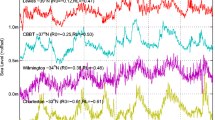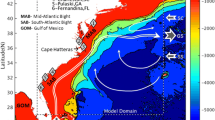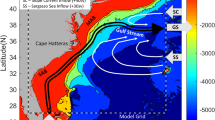Abstract
Two aspects of the interactions between the Gulf Stream (GS) and the bottom topography are investigated: 1. the spatial variations associated with the north-south tilt of mean sea level along the US East Coast and 2. the high-frequency temporal variations of coastal sea level (CSL) that are related to Gulf Stream dynamics. A regional ocean circulation model is used to assess the role of topography; this is done by conducting numerical simulations of the GS with two different topographies–one case with a realistic topography and another case with an idealized smooth topography that neglects the details of the coastline and the very deep ocean. High-frequency oscillations (with a 5-day period) in the zonal wind and in the GS transport are imposed on the model; the source of the GS variability is either the Florida Current (FC) in the south or the Slope Current (SC) in the north. The results demonstrate that the abrupt change of topography at Cape Hatteras, near the point where the GS separates from the coast, amplifies the northward downward mean sea level tilt along the coast there. The results suggest that idealized or coarse resolution models that do not resolve the details of the coastline may underestimate the difference between the higher mean sea level in the South Atlantic Bight (SAB) and the lower mean sea level in the Mid-Atlantic Bight (MAB). Imposed variations in the model’s GS transport can generate coherent sea level variability along the coast, similar to the observations. However, when the bottom topography in the model is modified (or not well resolved), the shape of the coastline and the continental shelf influence the propagation of coastal-trapped waves and impact the CSL variability. The results can explain the different characteristics of sea level variability in the SAB and in the MAB and help understand unexpected water level anomalies and flooding related to remote influence of the GS.









Similar content being viewed by others
References
Atkinson LP (1977) Modes of Gulf Stream intrusion into the South Atlantic Bight shelf waters. Geophys Res Lett 4(12):583–586
Bane JM, Brown OB, Evans RH, Hamilton P (1988) Gulf Stream remote forcing of shelfbreak currents in the Mid-Atlantic Bight. Geophys Res Lett 15(5):405–407
Baringer MO, Larsen JC (2001) Sixteen years of Florida current transport at 27N. Geophys Res Lett 28(16):3,179–3,182
Blaha JP (1984) Fluctuations of monthly sea level as related to the intensity of the Gulf Stream from Key West to Norfolk. J Geophys Res Oceans 89(C5):8033–8042
Boon JD (2012) Evidence of sea level acceleration at U.S. and Canadian tide stations, Atlantic coast, North America. J Coast Res 28(6):1437–1445. doi:10.2112/JCOASTRES-D-12-00102.1
Domingues R, Baringer M, Goni G (2016) Remote sources for year-to-year changes in the seasonality of the Florida Current transport. J Geophys Res. doi:10.1002/2016JC012070
Ducet N, Le Traon PY, Reverdin G (2000) Global high-resolution mapping of ocean circulation from TOPEX/Poseidon and ERS-1 and -2. J Geophys Res 105(C8):19477–19498. doi:10.1029/2000JC900063
Ezer T (1994) On the interaction between the Gulf Stream and the New England Seamount Chain. J Phys Oceanogr 24:191–204. doi:10.1175/1520-0485(1994)024
Ezer T (2001) Can long-term variability in the Gulf Stream transport be inferred from sea level? Geophys Res Lett 28(6):1031–1034. doi:10.1029/2000GL011640
Ezer T (2013) Sea level rise, spatially uneven and temporally unsteady: why the U.S. East Coast, the global tide gauge record, and the global altimeter data show different trends. Geophys Res Lett 40:5439–5444. doi:10.1002/2013GL057952
Ezer T (2015) Detecting changes in the transport of the Gulf Stream and the Atlantic overturning circulation from coastal sea level data: the extreme decline in 2009-2010 and estimated variations for 1935-2012. Glob Planet Change 129:23–36. doi:10.1016/j.gloplacha.2015.03.002
Ezer T (2016a) Revisiting the problem of the Gulf Stream separation: on the representation of topography in ocean models with different types of vertical grids. Ocean Model 104:15–27. doi:10.1016/j.ocemod.2016.05.008
Ezer T (2016b) Can the Gulf Stream induce coherent short-term fluctuations in sea level along the U.S. East Coast?: a modeling study. Ocean Dyn 66(2):207–220. doi:10.1007/s10236-016-0928-0
Ezer T, Atkinson LP (2014) Accelerated flooding along the U.S. East Coast: on the impact of sea-level rise, tides, storms, the Gulf Stream, and the North Atlantic oscillations. Earth’s Future 2(8):362–382. doi:10.1002/2014EF000252
Ezer T, Atkinson LP, Corlett WB, Blanco JL (2013) Gulf Stream’s induced sea level rise and variability along the U.S. mid-Atlantic coast. J Geophys Res 118:685–697. doi:10.1002/jgrc.20091
Goddard PB, Yin J, Griffies SM, Zhang S (2015) An extreme event of sea-level rise along the Northeast coast of North America in 2009–2010. Nat Commun 6. doi:10.1038/ncomms7346
Higginson S, Thompson KR, Woodworth PL, Hughes CW (2015) The tilt of mean sea level along the east coast of North America. Geophys Res Lett 42(5):1471–1479. doi:10.1002/2015GL063186
Hogg NG (1992) On the transport of the Gulf Stream between Cape Hatteras and the Grand Banks. Deep-Sea Res 39(7–8):1231–1246. doi:10.1016/0198-0149(92)90066-3
Hughes CW, Meredith PM (2006) Coherent sea-level fluctuations along the global continental slope. Philos Trans R Soc 364:885–901. doi:10.1098/rsta.2006.1744
Huthnance JM (2004) Ocean-to-shelf signal transmission: a parameter study. J Geophys Res 109(C12029). doi:10.1029/2004JC002358
Johns WE, Shay TJ, Bane JM, Watts DR (1995) Gulf Stream structure, transport, and recirculation near 68°W. J Geophys Res 100:817–817
Larnicol G, Guinehut S, Rio MH, Drévillon M, Faugere Y, Nicolas G (2006) The global observed ocean products of the French Mercator Project. Proceedings of the Symposium on 15 Years of Progress in Radar Altimetry, Edited by Danesy D, ISBN:92-9092-925-1. Noordwijk, Netherlands, European Space Agency, id.110
Legg S, Chang Y, Chassignet EP, Danabasoglu G, Ezer T, Gordon AL, Griffies S, Hallberg R, Jackson L, Large W, Ozgokmen T, Peters H, Price J, Riemenschneider U, Wu W, Xu X, Yang J (2009) Improving oceanic overflow representation in climate models: the Gravity Current Entrainment Climate Process Team. Bull Amer Met Soc 90(5):657–670. doi:10.1175/2008BAMS2667.1
Mellor GL, Hakkinen S, Ezer T, Patchen R (2002) A generalization of a sigma coordinate ocean model and an intercomparison of model vertical grids. In: Pinardi N, Woods ED (eds) Ocean forecasting: conceptual basis and applications. Springer, pp 55–72. doi:10.1007/978-3-662-22648-3_4
Montgomery R (1938) Fluctuations in monthly sea level on eastern U.S. Coast as related to dynamics of western North Atlantic Ocean. J Mar Res 1:165–185
Oey LY, Ezer T, Mellor GL, Chen P (1992) A model study of “bump” induced western boundary current variabilities. J Mar Sys 3:321–342. doi:10.1016/0924-7963(92)90009-W
Piecuch CG, Ponte RM (2015) Inverted barometer contributions to recent sea level changes along the northeast coast of North America. Geophys Res Lett 42(14):5918–5925. doi:10.1002/2015GL064580
Piecuch C, Dangendorf S, Ponte R, Marcos M (2016) Annual sea level changes on the North American Northeast Coast: influence of local winds and barotropic motions. J Clim 29:4801–4816. doi:10.1175/JCLI-D-16-0048.1
Richardson PL, Knauss JA (1971) Gulf Stream and western boundary undercurrent observations at Cape Hatteras. Deep-Sea Res 18(11):1089–1109. doi:10.1016/0011-7471(71)90095-7
Rossby T, Flagg C, Donohue K (2010) On the variability of Gulf Stream transport from seasonal to decadal timescales. J Mar Res 68:503–522
Sallenger AH, Doran KS, Howd P (2012) Hotspot of accelerated sea-level rise on the Atlantic coast of North America. Nature Clim Change 2:884–888. doi:10.1038/NCILMATE1597
Schoonover J, Dewar WK, Wienders N, Deremble B (2017) Local sensitivities of the Gulf Stream separation. J Phys Oceanogr 47(2). doi:10.1175/JPO-D-16-0195.1
Sturges W (1974) Sea level slope along continental boundaries. J Geophys Res 79(6):825–830. doi:10.1029/JC079i006p00825
Thompson PR, Mitchum GT (2014) Coherent sea level variability on the North Atlantic western boundary. J Geophys Res 119(9):5676–5689. doi:10.1002/2014JC009999
Woodworth PL, Maqueda MAM, Roussenov VM, Williams RG, Hughes CW (2014) Mean sea-level variability along the northeast American Atlantic coast and the roles of the wind and the overturning circulation. J Geophys Res 119:8916–8935. doi:10.1002/2014JC010520
Woodworth PL, Maqueda MM, Gehrels WR, Roussenov VM, Williams RG, Hughes CW (2016) Variations in the difference between mean sea level measured either side of Cape Hatteras and their relation to the North Atlantic Oscillation. Clim Dyn:1–19. doi:10.1007/s00382-016-3464-1
Xu F-H, Oey L-Y (2011) The origin of along-shelf pressure gradient in the Middle Atlantic Bight. J Phys Oceanogr 41(9):1720–1740. doi:10.1175/2011JPO4589
Yin J, Goddard PB (2013) Oceanic control of sea level rise patterns along the East Coast of the United States. Geophys Res Lett 40:5514–5520. doi:10.1002/2013GL057992
Zhao J, Johns W (2014) Wind-forced interannual variability of the Atlantic Meridional Overturning Circulation at 26.5°N. J Geophys Res Oceans 119:6253–6273. doi:10.1002/2013JC009407
Acknowledgments
Old Dominion University’s Climate Change and Sea Level Rise Initiative (CCSLRI) provided partial support for this study, and the Center for Coastal Physical Oceanography (CCPO) provided the computational facilities. Reviewers are thanked for providing many helpful suggestions.
Author information
Authors and Affiliations
Corresponding author
Additional information
Responsible Editor: Gianmaria Sannino
This article is part of the Topical Collection on the 8th International Workshop on Modeling the Ocean (IWMO), Bologna, Italy, 7–10 June 2016
Rights and permissions
About this article
Cite this article
Ezer, T. A modeling study of the role that bottom topography plays in Gulf Stream dynamics and in influencing the tilt of mean sea level along the US East Coast. Ocean Dynamics 67, 651–664 (2017). https://doi.org/10.1007/s10236-017-1052-5
Received:
Accepted:
Published:
Issue Date:
DOI: https://doi.org/10.1007/s10236-017-1052-5




